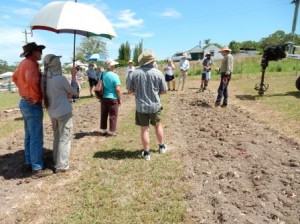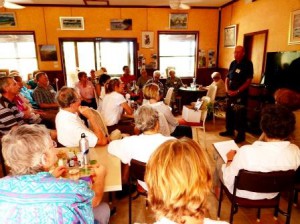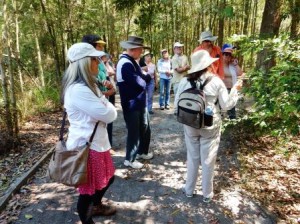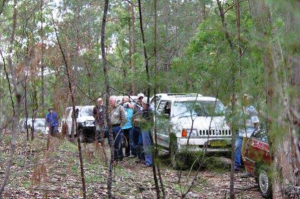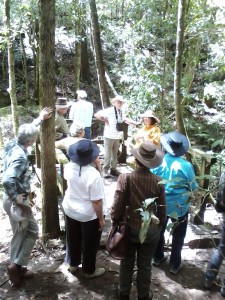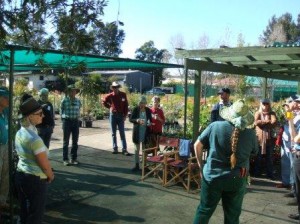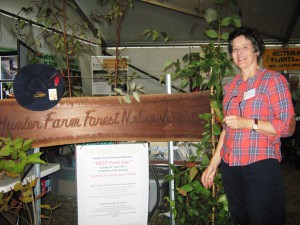Field Day November 2014
HFFN and the Hunter Local Land Services (HLLS) which provided funding had a very successful field day on tree planting led by Matt Kilby (Global Land Repair www.globallandrepair.com.au) and Noel Jupp (Riverdene Nursery www.riverdenenursery.com.au) demonstrating their proven methods. Forty five persons attended, undeterred by the heat, of which the majority were HFFN members. The field day was held at Wootton where HLLS is funding the plantation of thousands of trees with Noel providing the plants and Matt supervising the planting.
Some key points were: 6 months is required to prepare the land for planting by loosening the soil and removing weeds preferably without herbicide; the need to introduce fungi in the hole and not to fill the hole with water before planting; plants should be in a concave ditch that drains water to the root ball; a mat or compost/ wood chip is used to prevent the growth of weeds; the plants should be soaked in water for a week before planting and 20 litres poured on the plant when finished. If the weather is fine, it may not need further watering. Use a tree guard for the first 2 years.
The role of the mycorrhiza fungi and their interaction with plants can be read at http://www.cpbr.gov.au/fungi/mycorrhiza.html.
Noel said to improve soil he recommends that mulched and worm digested melaleuca styphelioides (prickly-leafed paper bark) is the very best but there is also a lack of these plants. Lantana, cabbages, ebony PR cow peas which can be planted and ploughed in in March before planting in April. Also, field lupins and he suggested planting pills which contain fertiliser and an insecticide and the use of blood and bone (the more odorous the better), to deter hares and wallabies.
An enjoyable lunch was provided by the Wootton Community Centre. Despite the high temperatures members felt a buzz of excitement learning from these 2 well known experts.
Matt with his hole digger preparing to plant Noel outlining his approach to growing seedlings
Field Day October 2014
The HFFN field day on 12th October was held at the Hunter Regional Botanic Gardens and attended by 22 members. Jenny, a volunteer with the Gardens, enthusiastically showed members around. We walked around many of the theme gardens, including a range of grevilleas and palms. Jenny revealed her vast knowledge of plants, birds and the environment to members with special emphasis on trees. The Blackbutts are native to the gardens and the planted flooded gums were also doing very well.
Lunch was provided by the Gardens staff and the AGM held afterwards with a new committee being elected. Minutes of the AGM have been circulated to members.
Jenny explaining aspects of the Gardens to members
Field Day August 2014
The weather forecast was not promising so planting by volunteers was cancelled, but surprisingly the day turned out fine and sunny. Members who took a chance on the weather enjoyed being shown around Ash Island by Rob Henderson from the Local Land Services.
We met in the old School Masters House which has been carefully restored. The Island has a mixture of areas: community gardens, cattle grazing, planting of eucalypts and even fruit trees. Restoration and preservation is the result of the work of volunteers and the CMA, now LLS. Rob finalised the visit with a BBQ at the Masters House.
Ash Island is named after the English Ash tree. We saw one of the few remaining trees and they are now being propagated. The other tree that used to be on the Island was red cedar but they were removed in the first twenty years of settlement.
The Island is now classified as a wetland of international importance.
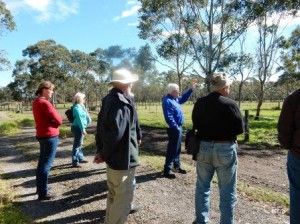 Rob discussing the plantation of six species of Eucalypti which have not grown very well
Rob discussing the plantation of six species of Eucalypti which have not grown very well
Field Day May 2014
The HFFN field day on 18th May was held at Chris and Ishbel Searle’s property at Howes Valley. From a site with initially only timber they have built their home, needing to use solar and rain water. They have a Private Native Forest agreement on their land and plan to manage the forest using silviculture principles.
As the property is surrounded by National Parks, preventing fires was of concern. Ken Ferguson from RFS and Keven Carter, an ex-forestry and National Parks employee spoke on the history and aims of low level burns, which had been recently carried out on the property. They emphasised the importance of back burning from the top of the hill down, and thinning the forest from the ground up. They named the five tree species known as The Royals in the forestry industry – ironbark, grey gum, turpentine, (all these grow in this area) tallow wood and white mahogany. These hardwoods were traditionally logged for railway sleepers and girders but are now in demand as high quality timber since the improvement in tools allows easier woodworking. Chris has too many Angophoras and is removing some to allow the Royals to take over.
Craig Tate, HFFN President and a forestry consultant, spoke about grants being available, particularly for forest corridors to be established and biodiversity in forested land.
A brief meeting moved and accepted the new constitution.
Field Day November 2013
For the final HFFN field day for 2013, fifteen members joined Patty and Karen who are involved in the management of the only significant rain forest near Sydney, the ‘Forest of Tranquillity’ at Ourimbah, for a walk through this magical place. The conditions were perfect in spite of the property receiving its largest rainfall in November. While everyone had their morning tea in a sheltered area, Patty alerted everyone to safety issues in the forest and a staff member gave an interesting talk about leeches. There are about 200 species of plants of which 50 are vines. A 5 km walk through the forest revealed extremely large and tall Sydney Blue Gums and Turpentine trees, rain forest trees and vines and a smaller area had mainly Bangalow Palms. The moisture content on the day was 90% – ideal for a rainforest along with creeks, a suitable soil and aspect.
A Private Vegetation Plan has been obtained, which ensures this unique place will be preserved.
Members thanked Patty and Karen for providing an insight into this forest, their future plans and sharing it.
A meeting was held during lunch time to discuss next year’s program, finalise the new constitution, collaborating with the Conservation Volunteers Australia and the ‘In Safe Hands Toolkit’ and general business.
Field day at Cootaame, Trevor Tops Rd and Upper Monkerai on 13th October 2013
Twenty three members and non-members gathered at two properties on a hot day to discuss appropriately hazard reduction. Kevin Carter, who had experience in National Parks, led the discussion. Hazard reduction is to preserve or protect assets such houses or buildings and includes keeping the property clear of vegetation through slashing. The direction and slope of the land will determine how many metres are required.
If there are more the 5 tons and less than 25 tons per hectare of under growth amongst trees, the fuel load, then a controlled burn may help. This requires advice from Rural Fire Service, notifying neighbours, ensuring the weather forecast is stable with temperature less than 25 degrees, humidity greater than 50%, and wind less than 15 km per hour, ensure easy access, that the controlled burning is contained and burn downhill. The leaf test can be used to measure humidity: leaf should burn when horizontal, but not when help upright.
Kevin also pointed out that there is a need to preserve trees with hollows, rain forest or riparian zones and some species do not resist fire (flooded gums). It is necessary to clear around these trees to ensure that they are safe. Smooth bark trees, white mahogany and iron bark are resistant to fire.
On inspecting the 2 properties, the first was well cleared, although from the West, the National Park over the road was the greatest threat. The second was also safe since the fuel load was low, and rain washes fallen leaves down into the creek.
With the problem of increasing and more severe fires this was a valuable education for members.
At lunch the AGM was held and Craig Tate accepted the position of President, and 2 new committee members were elected: Fred Fetherson and Nick Cameron. Below the new President addressing the members.
August Field Day 2013
Field day at Muswellbrook Forest Nursery on 11 August 2013
Over 20 people gathered at the Muswellbrook Forest Nursery on a perfect late winter’s day. After the customary long morning tea, Pauline Sykes, manager of the nursery took us for an extensive tour of the nursery. Expansion is the word, as the nursery is extending and investing in auto seeding machines. The nursery concentrates on local provenance stock
A couple of dozen Lomandra specimens were potted up after a demonstration that made it look easy.
HFFN member Fred talked about the mysteries of the early life of a Bunya Pine and demonstrated how to get them out of the ground. If you have tried to grow them, had initial growth and then “death”, go and look for the pot now – it is normal and it all happens under the ground.
Pauline talked about collecting seeds and the need for correct labelling and identification. The group went for seed collecting walk in the Muswellbrook State Forest!
Pauline has a love of native plants, a very green thumb and a passion for talking and teaching. Members took advantage of the 10% discount offered by the nursery on the day. It was a great day, thanks to Pauline.
June 2013 Field Day
Judy, Annabel and James gave a very interesting presentation of the work carried out on Judy’s property near Dungog of 250 acres. The property was bought in 2009 and Judy’s aim was to increase its biodiversity and conservation values as well as build a home, cabins, solar array and dam. The house was architecturally designed by a HHFN member (Peter Brecknock) and made use of existing logs and timbers to good effect. An aerial photo taken in the early 1950’s showed that the land was substantially cleared, presumably for logging timber. However, it now has a good mix of regrowth such as iron bark, spotted gum, grey box, white mahogany, and stringy bark trees which now need management as the basal area is over 25. After talks about the aims and methods of silviculture, we were taken to a site below the house where trees have been thinned: Annabel demonstrated how to poison the ‘loser’ trees and discussed which trees should be preserved. The same site was used to look at felled logs with defects to be sold for fire wood: the value of selling them might be $100 per cubic metre less $50 for removal, sawing, splitting, etc. One of the major problems with the forest was the abundance of lantana. After much hand pulling by Judy, two grants from the CMA and The Great Eastern Ranges were obtained to subsidise employing contractors with splatter guns to speed up the removal of the weed. Judy also demonstrated the use of her splatter gun. During the lunch break, Judy’s builder gave an interesting talk on straw bale construction, a method employed to build the bedrooms, cabins and wine cellar. The question that is often raised is: can biodiversity and conservation co-exist with timber production? This property showed how it could be done.
Annabel using a hatchet and poison to kill a deformed tree
TOCAL Exhibit May 3rd – 5th 2013
HHFN provided an exhibit at TOCAL within the CMA site on land care. The messages of the display were to show visitors photos of forest regrowth, examples of cut timber and the damages to the tree that had occurred, information on the next field day, and to provide an outline of what members of HHFN aim to achieve in terms preserving the forests in the Hunter area. Two members of HFFN gave talks on forestry to visitors. Several visitors expressed an interest in joining HFFN and received back copies of the Australian Agroforestry journal.
March 2013 Field Day
Glenn O’Rourke from the RFS at Wollombi gave a very relevant talk on preparing for bush fires to 20 members. He covered four areas:
1. Understanding risk
2. Fire danger ratings and alerts
3. Survival decisions and
4. Property preparation
There is evidence that bush fires are increasing in severity, and hence a new rating has been introduced: “catastrophic”. On catastrophic days, no properties can be defended, and it is necessary to leave the area early. Knowing the Fire Danger Rating can be obtained from TV, radio (local ABC), Internet (RFS site), mobile phones and GPS. A bush fire survival plan is necessary including ways to evacuate: the RFS web site has a guide. Property preparation is to reduce the fuel around buildings. On flat ground 20 metres of slashing and removing the fuel is required: for slopes, 50-90 metres would be required. One clear message is that it is not appropriate to ignore the risk of fires and land holders must have a plan, even if there has been no fire for many years: recall Canberra and Victorian fires.
After lunch, members looked at Pierre Louys’ property near Wards River. Pierre has had the property for 7 years and initially purchased it for environmental reasons. But after courses on managing private native forests, he realised that silviculture was required to allow the better trees to prosper. One area has been harvested and the remainder left alone: 3 trees were measured in each site in 2009 and members measured the diameters in 2013. Two trees in the harvested site grew faster than those in the other site, while data was missing on the 3rd treee.
